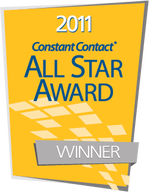|
Email Newsletters
Direct Mail P.R. Presentations -PowerPoint, Keynote Website Creation QR Codes Social Media Felicity has been awarded the Constant Contact All-Star Award in 2009, 2010 and 2011 (i.e. since she started using Constant Contact). The All Star Awards are the way Constant Contact recognizes marketers who stand out from the more than 500,000 organizations who use their services. Each year Constant Contact recognizes the top 10% of their customers with consistently high open rates (greater than 25%), click through rates, and low bounce rates.
"Only 10% of our customers achieve All Star status every year. That you've managed to do it for consecutive years puts you in an even more elite class, which makes your accomplishment even more noteworthy." Constant Contact |
Why E-Newsletters?
|
